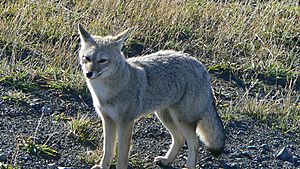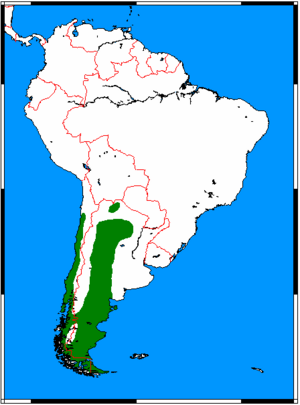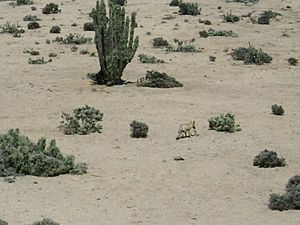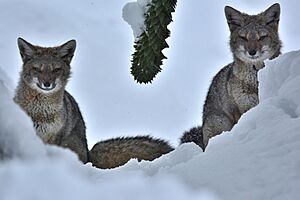South American gray fox facts for kids
Quick facts for kids South American gray fox |
|
|---|---|
 |
|
| Conservation status | |
| Scientific classification | |
| Genus: |
Lycalopex
|
| Species: |
griseus
|
 |
|
| Distribution of the South American gray fox | |
| Synonyms | |
|
|
The South American gray fox (Lycalopex griseus) is also known by other names. These include the Patagonian fox, the chilla, or the gray zorro. It belongs to a group of animals called "false" foxes, which are part of the Lycalopex genus. This fox lives only in the southern parts of South America.
Contents
About the South American Gray Fox
The South American gray fox is a small animal. It looks a lot like a fox. It is a type of canid, which means it's related to dogs. These foxes usually weigh between 2.5 and 5.45 kilograms (about 5.5 to 12 pounds).
From its nose to the tip of its tail, it measures about 65 to 110 centimeters (25 to 43 inches). Its tail alone can be 20 to 43 centimeters long (8 to 17 inches).
Its head is a mix of reddish-brown and white. The fox has large ears. You can also see a clear black spot on its chin. Its fur is a mix of colors, with longer, rougher hairs and a soft, light undercoat. The belly area is light gray. Its legs are a yellowish-brown color. There is a dark stripe across its upper legs. The tail is long and bushy. It has a dark stripe on top and a dark tip. The underside of the tail is lighter and mottled.
Where They Live and What Their Home Is Like
The South American gray fox lives in Argentina and Chile. These countries are in the southern part of South America. You can find them on both sides of the Andes mountains. Their range stretches from northern Chile (around 17ºS) all the way down to Tierra del Fuego (around 54ºS).
In Argentina, these foxes live in the dry western areas. This includes places near the Andes mountains. South of the Río Grande river, the foxes spread out more. They can even be found near the Atlantic coast. In Chile, you can find them almost everywhere in the country. Some people have said they are in Peru, but this has not been officially confirmed.
These foxes were also brought to the Falkland Islands a long time ago. This happened in the late 1920s or early 1930s. They still live there in good numbers on islands like Beaver and Weddell, plus some smaller islands.
The South American gray fox can live in many different places. This includes warm, dry scrublands in Argentina. They also live in the cold, dry Patagonian steppe. You can even find them in the forests of southern Chile.
What the South American Gray Fox Eats
What these foxes eat can change. It depends on where they live. It also depends on the time of year. Their diet mostly includes small mammals and birds. They also eat insects, bird eggs, and reptiles. Sometimes they eat fruit and dead animals (carrion).
Their favorite foods seem to be small mammals. Rodents are a big part of their diet. They also eat certain fruits.
Reproduction and Life Cycle
South American gray foxes usually have their babies in the early autumn. This is around March in the southern hemisphere. After being pregnant for about two months, the mother fox gives birth. She usually has two to four babies, called kits. The kits are born in a den. Not much more is known about their daily lives and habits.
How They Interact with Their Environment

Near People (Urban Areas)
The South American gray fox usually lives alone. For a long time, people hunted these foxes for their fur. Sometimes, these foxes go near places where humans live. They might be looking for food like chickens or sheep. However, they usually try to stay away from areas where dogs are present.
These foxes are helpful to the environment. They act as scavengers, cleaning up dead animals. They also help spread the seeds of the fruits they eat.
In the Wild (Country Areas)
In some places, the South American gray fox lives in the same areas as the larger culpeo fox. This means they compete for food. The gray fox eats more small animals like rodents. Insects are also a big part of its diet. The culpeo fox, however, tends to hunt larger animals. This includes the European hare, which was brought to Chile.
These two fox species share the available prey. The culpeo fox is bigger. So, it often takes the best hunting grounds from the smaller gray fox.



